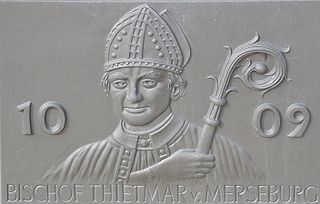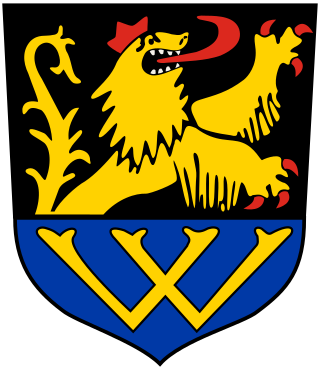
The Northern March or North March was created out of the division of the vast Marca Geronis in 965. It initially comprised the northern third of the Marca and was part of the territorial organisation of areas conquered from the Wends. A Lutician rebellion in 983 reversed German control over the region until the establishment of the March of Brandenburg by Albert the Bear in the 12th century.

Thietmar, Prince-Bishop of Merseburg from 1009 until his death, was an important chronicler recording the reigns of German kings and Holy Roman Emperors of the Ottonian (Saxon) dynasty. Two of Thietmar's great-grandfathers, both referred to as Liuthar, were the Saxon nobles Lothar II, Count of Stade, and Lothar I, Count of Walbeck. They were both killed fighting the Slavs at the Battle of Lenzen.
Herman I was the first Conradine Duke of Swabia, the son of Gebhard, Duke of Lorraine, and a cousin of King Conrad I of Germany.
Henry of Schweinfurt was the Margrave of the Nordgau from 994 until 1004. He was called the "glory of eastern Franconia" by his own cousin, the chronicler Thietmar of Merseburg.
Lothair I was Margrave of the Nordmark from about 983 until his death. He was also a member of Saxon nobility as Count of Derlingau and of Nordthüringgau.

The Battle of Lenzen was a land battle between a Saxon army of the Kingdom of Germany and the armies of the Slavic Redarii and Linonen peoples, that took place on 4 September 929 near the fortified Linonen stronghold of Lenzen in Brandenburg, Germany. The Saxon army, commanded by Saxon magnate Bernhard, destroyed a Slavic Redarii army. It marked the failure of Slavic attempts to resist German king Henry the Fowler's expansionism to the Elbe.

The Counts of Stade were members of the Saxony nobility beginning in the 10th century. Stade had developed since the 8th century as a principal center of trade and communications. The Counts of Stade created their domain between the lower Elbe and Weser rivers. They extended their power northwards with the acquisition of Dithmarschen in the 11th century. They became the Margraves of the Nordmark in 1056. There is also a close political and familial relationship between the Counts of Stade and the Counts of Walbeck. The Northern March was replaced with the March of Brandenburg by Albert the Bear in the 12th century. The family of Counts of Stade is referred to as the House of Udonids.
Lothar II (874-929), Count of Stade, son of Lothar I, Count of Stade, and Oda of Saxony, daughter of Liudolf, Duke of Saxony. Lothar was the great-grandfather of Thietmar of Merseburg, and is frequently confused in genealogical sources with Thietmar’s other great-grandfather of the same name who was Count of Walbeck.
Henry I the Bald was Count of Stade. He was son of Lothar II, Count of Stade, and Swanhild of Saxony. Henry is recorded as a cousin of Otto I, Holy Roman Emperor, but their exact relationship remains a mystery. Henry was also appointed Count of Heilangau, the ancient capital of Stade, in 959.

The Counts of Walbeck ruled a medieval territory with its capital Walbeck northeast of Helmstedt in the present town Oebisfelde-Weferlingen in Saxony-Anhalt. The foundation of the Archbishopric of Magdeburg established the region as firmly in the oversight of Otto the Great, Holy Roman Emperor. The first Count of Walbeck, Lothar I, was great-grandfather of Thietmar, Prince-Bishop of Merseburg, chronicler of the Ottonian dynasty of Germany and the Holy Roman Empire. Two of Thietmar’s great-grandfathers, both named Lothar, were killed in the Battle of Lenzen, pitting the forces of Henry the Fowler against the Slavs. The early Margraves of the Nordmark were descended from the House of Walbeck.
Siegfried I, Count of Stade, son of Lothar II, Count of Stade, and Swanhild of Saxony, brother of Henry I the Bald, Count of Stade.
Henry II the Good (946–1016), Count of Stade, son of Henry I the Bald, Count of Stade, and his wife Judith von der Wetterau, granddaughter of Gebhard, Duke of Lorraine.
Lothair Udo I, Count of Stade, son of Henry I the Bald, Count of Stade, and his wife Judith von der Wetterau, granddaughter of Gebhard, Duke of Lorraine. Lothair is frequently confused with his nephew Lothair Udo II, son of his brother Siegfried II, who was Margrave of Nordmark as Lothair Udo I.
Siegfried II, Count of Stade, was the youngest son of Henry I the Bald, Count of Stade, and his wife Judith von der Wetterau, granddaughter of Gebhard, Duke of Lorraine. He succeeded his brother, Henry as Count of Slade in 1016.
Lothar II the Elder, Count of Walbeck, son of Lothar I, Count of Walbeck.
Siegfried I the Elder, Count of Walbeck and Möckerngau, son of Lothar II the Old, Count of Walbeck, and Mathilde von Arneburg.
Henry, Count of Walbeck, son of Siegfried I the Older, Count of Walbeck, and Kunigunde von Stade, daughter of Henry I the Bald, Count of Stade. Virtually all that is known about Henry was provided in the chronicle of his brother Thietmar of Merseburg.
Friedrick, Count of Walbeck and Viscount (Burggraf) of Magdeburg, son of Siegfried I the Older, Count of Walbeck, and Kunigunde von Stade daughter of Henry I the Bald, Count of Stade. He was brother to Thietmar of Merseburg, whose Chronicon was the main source of information on him, and his predecessor Henry, Count of Walbeck.
Conrad (1018–1073), Count of Walbeck and Viscount (Burggraf) of Magdeburg, son of Friedrick, Count of Walbeck, and Thietburga. There is little known about Conrad's reign.
Gero was a Count of Alsleben, conjectured to be the son of Siegfried and therefore grandson of Gero the Great. If so, his mother was Hedwig, daughter of Wichmann the Elder. Gero was the brother of Tetta, who established a monastery at Alsleben in his name. Thietmar of Merseburg, whose Chronicon is the major source of information here, refers to Gero as a Count in Northern Thuringia and Morzani. Gero was married to Adela of an unknown family. Gero and Adela had one daughter, Adela of Alsleben, who married Siegfried II, Count of Stade. No other counts of Alsleben are recorded until the 12th century.




